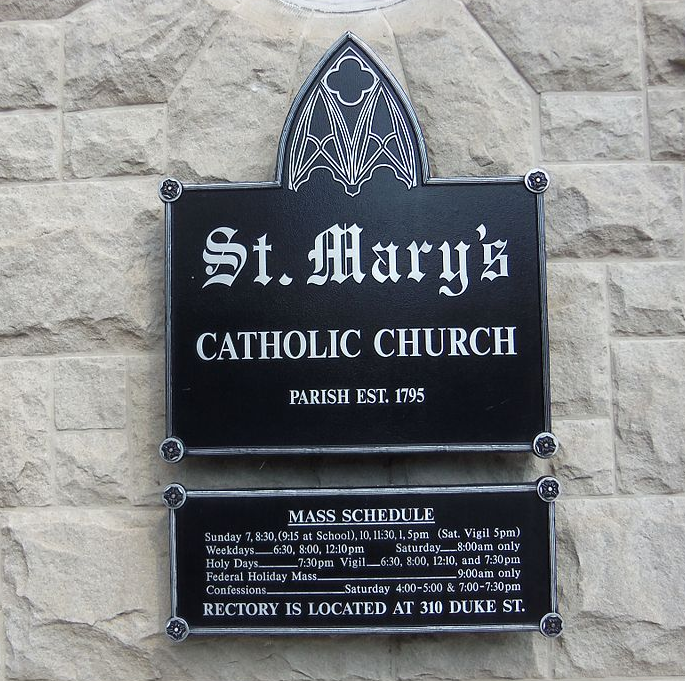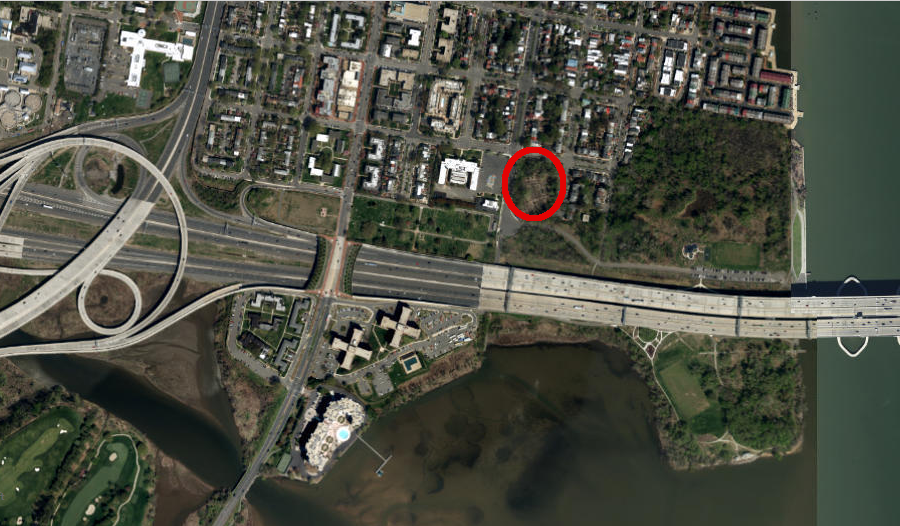
construction of the first Catholic church in Virginia began in 1795, in Alexandria
Source: Wikipedia, The church sign on Saint Mary's Catholic Church in Alexandria, Virginia

construction of the first Catholic church in Virginia began in 1795, in Alexandria
Source: Wikipedia, The church sign on Saint Mary's Catholic Church in Alexandria, Virginia
The first Christian church in North America was built in 1572 in St. Augustine, Florida. It was a Catholic church, since the Spanish king and his colonists were Catholic. The Jamestown colonists initiated a Protestant alternative in North America over three decades after the Catholics.
Spanish explorers held Catholic services in various places prior to construction of the St. Augustine church. In 1570, Spanish settlers in what is now Virginia built a small chapel near modern-day Yorktown.
The first Catholic chapel in Virginia was a small hut erected by the Jesuit priests led by Father Juan Baptista de Segura. The 11 Jesuits were accompanied by a Native American who had been seized earlier in Virginia. The man known originally as Paquiquineo had been renamed Don Luis de Velasco by the Spanish, and he may have worshiped with the priests before quickly abandoning the colony the Spanish called Ajacan.
The Jesuits built their chapel using lumber and nails which they had brought from Cuba, and had hauled across the Peninsula from where they landed near modern-day Kingsmill. The chapel was located near the Native American town of Kiskiak, on the southern bank of what the English would later call the York River. In 1571, 10 of the 11 Spanish were killed and Catholic services ended when Ajacan was destroyed.1
Source: Historical Context, Before Jamestown: The Spanish Mission and Massacre in Virginia
The next church built in Virginia was erected in 1608, for Anglican services in Jamestown. That church was constructed after fire within the fort burned the sailcloth which had provided a covering for worship services since the colonists first arrived in 1607. The first church building in Jamestown was "a homely thing like a barn set on crachetts, covered with rafts, sedge and earth."2
The first dedicated Catholic church in Virginia, the Church of Saint Mary in Alexandria, was built almost two centuries later.
Alexandria was a port town, and sailors who arrived there starting in 1749 had various religious faiths. In 1781, Catholics in the French army celebrated Mass at Bruton Parish Church in Williamsburg after the victory at Yorktown. On the way back north in 1782, they celebrated another Mass in Alexandria, but there was no permanent structure for Catholic worship then. Official discrimination against Catholics continued until the General Assembly passed a "Bill for Establishing Religious Freedom" in 1786.
In 1788, fundraising began to build a Catholic church. Actual construction of the Church of Saint Mary started in 1795. That was 225 years after the first Christian worship services in Virginia, the ceremonies held in 1570 by Spanish Jesuits on the Peninsula. The first building in Alexandria, a small chapel, was completed a year later. The President of Georgetown College in Washington, DC, a Jesuit, served as a priest who could say Mass.3
The church received support from local community leaders, who were all Protestants. The mayor of Alexandria had allowed Mass to be held in his own home before St. Mary was constructed. The ideals of the American Revolution may have played a part in getting support. The church claims that the first donation to the building fund came from George Washington.4
Alexandria's leaders already were accustomed to dealing with the many Catholics in Maryland. Jesuits from Maryland served as early priests at the Church of Saint Mary, and it was part of the Diocese of Baltimore until 1858.5
The first church was completed in 1796. In 1826, a new structure opened in a more-central location and is part of the current church building at 310 South Royal Street The original site of the first church became the first Catholic cemetery in Virginia
The current building was designed as a "minor" basilica by the Pope in 2018. The designation means that the Basilica of Saint Mary has a special relationship with the Pope, and celebrates special services on certain liturgical days.6

the site of the Church of Saint Mary, started in 1795, is now the cemetery of the Basilica of Saint Mary
Source: ESRI, ArcGIS Online